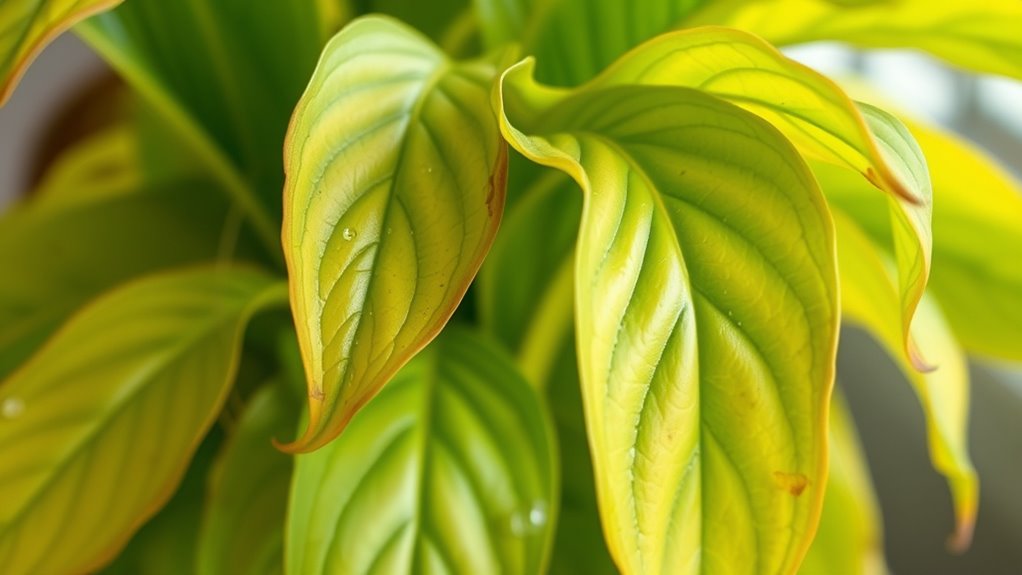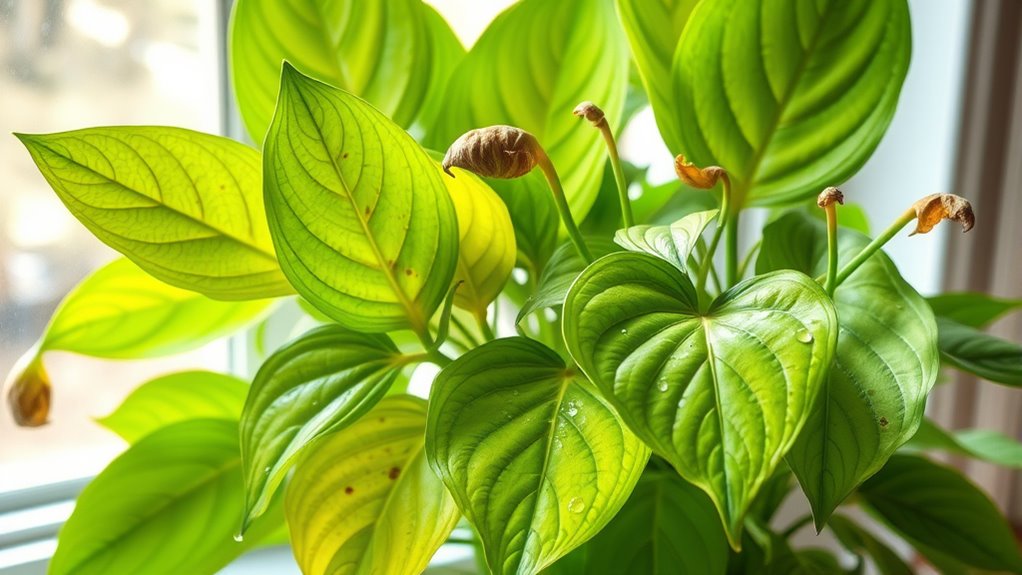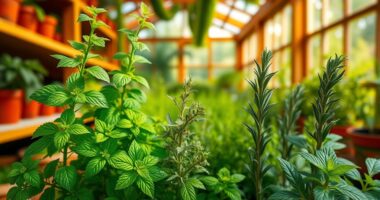To diagnose yellow leaves and wilting, start by checking your watering habits—overwatering causes root rot, while underwatering leads to dehydration. Look for pests like aphids or spider mites that may cause leaf damage. Examine soil moisture with your finger or a meter, and make sure proper drainage. Wilting can result from water stress or root problems; adjusting watering and inspecting roots helps. For more tips on keeping your plants healthy, keep exploring these common issues.
Key Takeaways
- Check soil moisture to distinguish between overwatering and underwatering as causes of yellowing or wilting.
- Inspect for pests like aphids or spider mites that can damage leaves and cause discoloration.
- Ensure proper drainage and avoid constant soil saturation to prevent root rot and related issues.
- Observe leaf edges and overall plant health to identify dehydration or nutrient deficiencies.
- Maintain a consistent watering schedule, monitor environmental conditions, and treat pest infestations promptly.

When your plants start showing signs of trouble, it can be frustrating, but quick troubleshooting can often save them. One common issue is yellowing leaves, which often points to watering issues or pest infestations. Overwatering can suffocate roots, leading to root rot and nutrient deficiencies that turn leaves yellow. Conversely, underwatering causes dehydration, making leaves wilt and turn yellow or brown at the edges. To troubleshoot, check the soil moisture with your finger or a moisture meter. If the soil feels soggy, cut back on watering and ensure your pot has proper drainage. If it’s dry, increase watering frequency, but avoid soaking the soil constantly. Pest infestation can also cause yellowing, especially if pests like aphids, spider mites, or scale insects are feeding on your plant. Inspect the undersides of leaves and stems closely, looking for tiny bugs or sticky residue. If pests are present, treat the plant with insecticidal soap or neem oil, and wipe away any visible pests to prevent further damage. Proper nutrition can also play a vital role; providing balanced fertilization supports overall plant health and helps prevent issues like yellowing leaves. Regular fertilization and soil testing can help identify deficiencies early. Wilting is another sign of distress that often confuses growers. When plants wilt, it’s usually due to water stress—either too little or too much. If the soil feels dry, your plant isn’t getting enough water, which causes the cells to lose turgor pressure and the plant to droop. Water thoroughly, allowing excess to drain out, and monitor how quickly the soil dries out to establish a consistent watering schedule. On the other hand, overwatering can lead to root rot, which impairs the plant’s ability to absorb water properly, resulting in wilting despite moist soil. In this case, you should let the soil dry out and consider repotting if root rot is suspected. Additionally, pests can cause wilting by damaging roots or stems, so always inspect your plant for pests and treat accordingly. Other issues like leaf spots, stunted growth, or leaf curling often stem from nutritional deficiencies, environmental stress, or pests. Proper diagnosis is key; examine your plant’s growing conditions, watering habits, and look for signs of pests. Maintaining proper watering routines—watering when the top inch of soil feels dry—and regularly inspecting for pests can prevent many problems. Ensuring your plant receives adequate light, humidity, and soil conditions will also promote healthy growth and help avoid stress-related issues. Regularly checking the soil quality can help identify problems early before they escalate. Being aware of plant-specific care requirements can further improve your troubleshooting efficiency. By staying attentive and proactive, you’ll catch issues early and give your plants the best chance to recover and thrive.
Frequently Asked Questions
How Often Should I Water My Plant to Prevent Yellow Leaves?
You should water your plant based on its specific needs, but generally, maintaining a consistent watering schedule helps prevent yellow leaves. Avoid overwatering by checking the soil’s moisture level; only water when the top inch feels dry. Good drainage is vital to prevent drainage issues, which can lead to root rot and yellowing. Adjust your watering routine accordingly, and always make certain your pot has proper drainage to keep your plant healthy.
What Soil Ph Levels Are Ideal for Common Houseplants?
Did you know that most houseplants thrive in soil with a pH between 6.0 and 7.0? You can measure soil pH using simple pH test kits or digital meters. For ideal growth, consider soil amendment tips like adding sulfur to lower pH or lime to raise it. Regular pH measurement guarantees your plants stay healthy, preventing issues like yellowing leaves or poor nutrient absorption.
How Can I Tell if Pests Are Causing My Plant’s Problems?
To tell if pests are causing your plant’s problems, look for pest signs like sticky residue, webbing, or tiny insects on leaves and stems. Damage identification also helps; check for holes, chewed edges, or discolored spots. Regularly inspect your plant closely, especially undersides of leaves. If you notice these pest signs or damage, it’s likely pests are the culprits, and you should act promptly to treat the issue.
Are There Specific Fertilizers for Recovering Wilting Plants?
Imagine your plant’s desperation as if it’s crying out for help—because it is! For recovering wilting plants, you need the right fertilizer types that target nutrient deficiencies. Look for balanced fertilizers rich in nitrogen, potassium, and phosphorus. Slow-release options work best to steadily restore energy. Avoid over-fertilizing, which can worsen the problem. Tailoring your approach guarantees your plant gets exactly what it needs to bounce back from the brink!
What Temperature Range Is Best for Plant Recovery?
For your plant’s recovery, maintain a temperature range between 65-75°F (18-24°C). Proper temperature regulation helps reduce stress and promotes healing. Additionally, humidity control is essential—aim for moderate humidity levels to prevent dehydration. Avoid sudden temperature fluctuations or drafts, as these can hinder recovery. Keeping your plant in a stable environment with ideal temperature and humidity conditions supports healthy growth and encourages it to bounce back quickly.
Conclusion
By paying close attention to your plant’s symptoms, you can often identify and fix issues before they worsen. Remember, healthy plants reflect your care and understanding. When you notice yellowing leaves or wilting, ask yourself if you’ve checked your watering habits or lighting conditions. Isn’t it rewarding to see your plant thrive again with just a little troubleshooting? With patience and observation, you’ll become confident in keeping your green friends happy and healthy.









